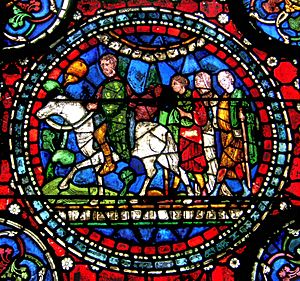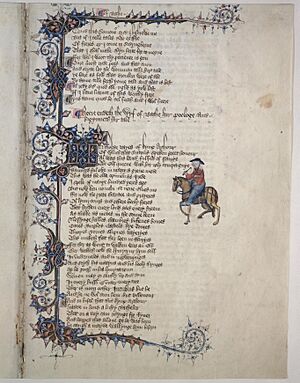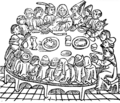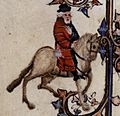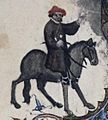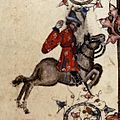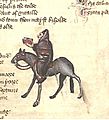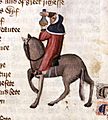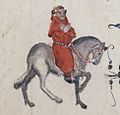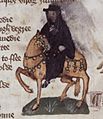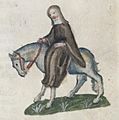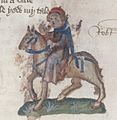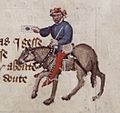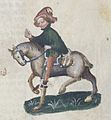The Canterbury Tales facts for kids
The Canterbury Tales is a famous book of stories written by Geoffrey Chaucer. He wrote it in the 14th century, which was a long time ago! It was one of the first important books written in the English language.
The book is about a group of pilgrims. They are traveling from London to Canterbury. To make the long journey more fun, each person tells a story. Chaucer planned for each pilgrim to tell four stories, but he only finished 24 of them. Most of the stories are written as verse (like poems), but two are written in prose (like regular writing). These stories were so popular that Chaucer was asked to read them to the king!
Contents
Why Pilgrims Traveled to Canterbury
Canterbury Cathedral
The Canterbury Tales is about people going on a pilgrimage. A pilgrimage is a special journey to a sacred site (a holy place). In the Middle Ages, many Christian people traveled to places like Jerusalem, Rome, and Santiago de Compostela.
Canterbury Cathedral was a very famous place for pilgrims to visit. This was because it held the shrine of Saint Thomas Becket. A shrine is a special place built to remember someone important.
Thomas Becket
Thomas Becket was the Archbishop of Canterbury in the 1100s. He had an argument with his old friend, King Henry II. In 1170, some of the King's knights killed Thomas Becket.
The King felt very sad about what happened. He had a beautiful tomb built for his friend. Soon, people started visiting the tomb. Some even said that Thomas Becket was a saint and that miracles happened there. He is seen as a martyr (someone who dies for their beliefs) and a saint by both the Roman Catholic and Anglican churches. His shrine made Canterbury one of the most important pilgrimage sites in Europe.
Who Were the Pilgrims?
Many pilgrims used to meet in London before starting their journey. In The Canterbury Tales, the group meets at an inn in Southwark. This area was south of the Thames River and is now part of London. It was a good meeting spot because people from the north could cross London Bridge there.
Canterbury is in the south-east of England. Pilgrims often traveled in groups because it was safer. In those days, people carried a lot of money for food and accommodation (places to sleep). Robbers were a real danger on the roads.
When pilgrims traveled together, the group could include many different kinds of people. There were rich and poor, noble and humble. Often, there were religious people like priests, monks, and nuns. In Chaucer's story, the most important person in the group is a knight.
The Stories in the Book
The Canterbury Tales starts with a Prologue. A prologue is like an introduction that sets the scene. In this prologue, Chaucer describes the time of year, which is April. He says that when the weather gets warmer, people start their pilgrimages.
Chaucer then describes each person gathered at the inn. He makes them so clear that many have become famous characters in English literature. He tells us how each person tells a story to entertain the others on their journey.
The Tales include:
- The General Prologue
- The Knight's Tale
- The Miller's Prologue and Tale
- The Reeve's Prologue and Tale
- The Cook's Prologue and Tale
- The Man of Law's Prologue and Tale
- The Wife of Bath's Prologue and Tale
- The Friar's Prologue and Tale
- The Summoner's Prologue and Tale
- The Clerk's Prologue and Tale
- The Merchant's Prologue and Tale
- The Squire's Prologue and Tale
- The Franklin's Prologue and Tale
- The Physician's Tale
- The Pardoner's Prologue and Tale
- The Shipman's Tale
- The Prioress' Prologue and Tale
- Chaucer's Tale of Sir Topas
- The Tale of Melibee
- The Monk's Prologue and Tale
- The Nun's Priest's Prologue and Tale
- The Second Nun's Prologue and Tale
- The Canon's Yeoman's Prologue and Tale
- The Manciple's Prologue and Tale
- The Parson's Prologue and Tale
- Chaucer's Retraction
Some of the stories are serious, while others are very funny. Some of the funny ones can be a bit rude! Many of the tales talk about the Christian faith. Sometimes, the theme (main idea) of one story leads into the next. This happens when a new storyteller responds to a story they just heard. All the tales explore how people think and act towards each other.
About The Canterbury Tales
The Canterbury Tales is written in the kind of English that ordinary people spoke in Chaucer's time. Chaucer was one of the first writers to create stories in English. Before him, most stories were written in Latin or French. Other writers like John Gower and William Langland also started writing in English around the same time.
Chaucer planned to write 120 stories, but he only finished 24. He started writing them in the 1380s and stopped in the 1390s. Some people think he might have chosen not to finish all 120 stories.
Chaucer was an important person in the royal court (the king's advisors and friends). Some people believe that Chaucer used his stories to share ideas about court politics (how the government and powerful people worked). It's also thought that his characters might be based on real people he knew at court.
Some of the stories in The Canterbury Tales are similar to other writings from that time. However, Chaucer's characters are very unique. They have different jobs and personalities. They also tell different types of stories in their own special ways.
The main story is about the pilgrims traveling to Canterbury. They ride horses, and the trip takes several days. Chaucer doesn't focus much on the journey itself. Most of the book is about the interesting stories the pilgrims tell.
The two oldest handwritten copies of The Canterbury Tales are the Hengwrt manuscript and the Ellesmere manuscript. There are also many other copies made before the year 1500. These copies have some differences. Experts are working on The Canterbury Tales Project to study all these copies. Their goal is to find the differences and create the most accurate version of the book.
See also
 In Spanish: Los cuentos de Canterbury para niños
In Spanish: Los cuentos de Canterbury para niños
Images for kids
-
A woodcut from William Caxton's second edition of The Canterbury Tales printed in 1483
-
A Tale from the Decameron by John William Waterhouse
-
Canterbury Cathedral from the north west circa 1890–1900 (retouched from a black & white photograph)
-
The Peasants' Revolt of 1381 is mentioned in the Tales.


